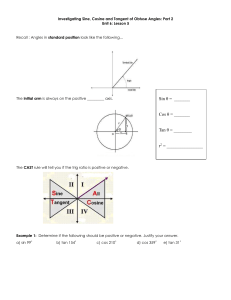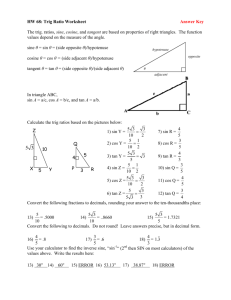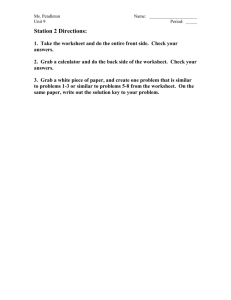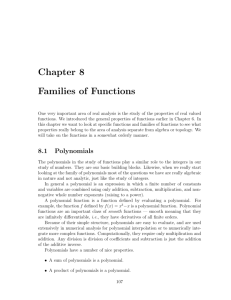Solutions Part I
advertisement
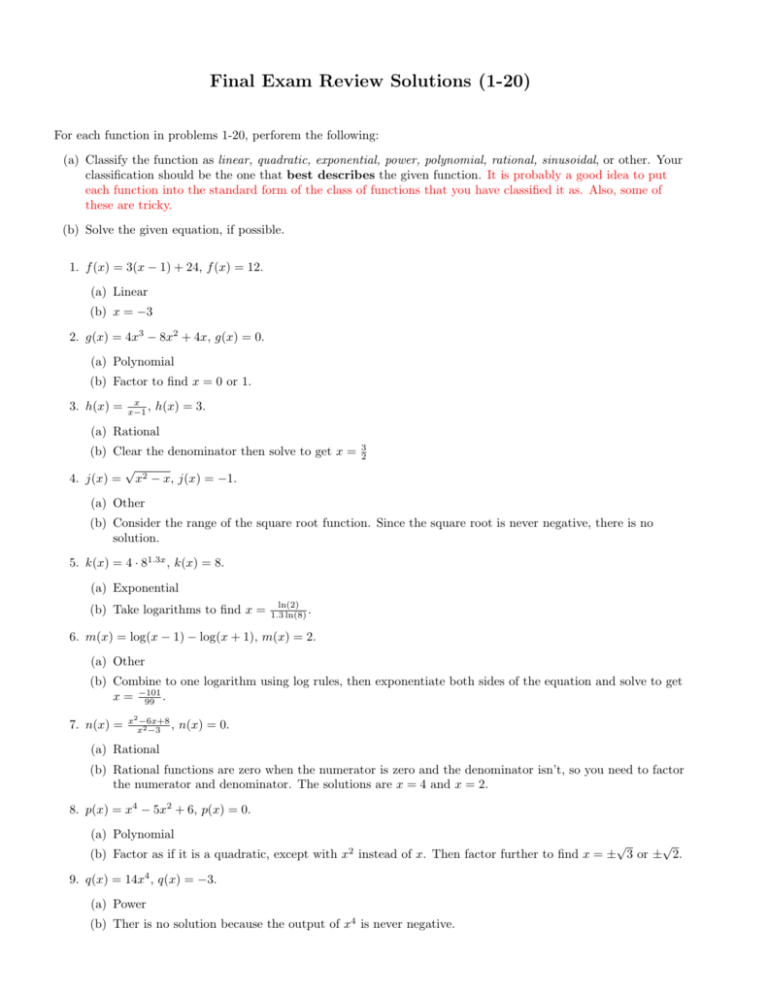
Final Exam Review Solutions (1-20) For each function in problems 1-20, perforem the following: (a) Classify the function as linear, quadratic, exponential, power, polynomial, rational, sinusoidal, or other. Your classification should be the one that best describes the given function. It is probably a good idea to put each function into the standard form of the class of functions that you have classified it as. Also, some of these are tricky. (b) Solve the given equation, if possible. 1. f (x) = 3(x − 1) + 24, f (x) = 12. (a) Linear (b) x = −3 2. g(x) = 4x3 − 8x2 + 4x, g(x) = 0. (a) Polynomial (b) Factor to find x = 0 or 1. 3. h(x) = x x−1 , h(x) = 3. (a) Rational (b) Clear the denominator then solve to get x = √ 4. j(x) = x2 − x, j(x) = −1. 3 2 (a) Other (b) Consider the range of the square root function. Since the square root is never negative, there is no solution. 5. k(x) = 4 · 81.3x , k(x) = 8. (a) Exponential (b) Take logarithms to find x = ln(2) 1.3 ln(8) . 6. m(x) = log(x − 1) − log(x + 1), m(x) = 2. (a) Other (b) Combine to one logarithm using log rules, then exponentiate both sides of the equation and solve to get x = −101 99 . 7. n(x) = x2 −6x+8 x2 −3 , n(x) = 0. (a) Rational (b) Rational functions are zero when the numerator is zero and the denominator isn’t, so you need to factor the numerator and denominator. The solutions are x = 4 and x = 2. 8. p(x) = x4 − 5x2 + 6, p(x) = 0. (a) Polynomial √ √ (b) Factor as if it is a quadratic, except with x2 instead of x. Then factor further to find x = ± 3 or ± 2. 9. q(x) = 14x4 , q(x) = −3. (a) Power (b) Ther is no solution because the output of x4 is never negative. 10. r(x) = 3 sin(−2πx) + 4, r(x) = 4. (a) Sinusoidal (b) First figure out what sin(−2πx) must equal, then use that to figure out what x must be. You will find x = ± n2 where n = 0, 1, 2, . . .. 11. F (x) = 3 · 4log(x) , F (x) = 12. (a) Power when x > 0 as 4log(x) = xlog(4) (see if you can prove this) when x > 0. (b) Either take a log(4) root, or just figure out that log(x) must be 1, so x = 10 12. G(x) = 8(x − 2)2 + 9, G(x) = 10. (a) Quadratic q (b) x = ± 18 + 2 13. H(x) = sin(2x) − cos(x), H(x) = 0. (a) Other 5π (b) Use the double angle identity for sin(2x), then factor. x = ± π2 , ± 3π 2 , ± 2 , . . . as well as 5π 6 ± 2nπ for n = 0, 1, 2, . . .. √ 14. J(x) = x2 −1 , x π 6 ± 2nπ and J(x) = −1. (a) Other √ (b) No solution. Note that it isn’t because x2 − 1 is never negative. 15. K(x) = sin(3x) − 4 cos(3x), K(x) = 0. (a) Sinusoidal. (b) Re-write in the form A sin(3x + φ) and get x = nπ−tan−1 (−4) 3 for n = 0, ±1, ±2, . . .. Also, you can notice that this equation can be re-written as tan(3x) = 4, which gives solutions of the form x = These two solution sets are the same because tan−1 is an odd function. 16. M (x) = sin2 (x)−1 cos(x) nπ+tan−1 (4) . 3 + cos(x), M (x) = 0. (a) Other, although after you use an identity you find M (x) = 0 when M (x) is defined. 5π (b) x 6= ± π2 , ± 3π 2 ,± 2 ,... 17. N (x) = ln(2x + 5) ln(x2 + 1), N (x) = 0. (a) Other (b) Use the fact that this is factored, so you need to set each logarithmic function equal to zero. This happens when x = 0 or x = −2. 18. P (x) = 2−(x−5)/3 , P (x) = 6. (a) Exponential (b) x = −3 ln(6) ln(2) + 5. 19. Q(x) = 1 x − 1 x2 −1 , Q(x) = 9. (a) Rational. (b) Clear denominators to obtain a degree 3 polynomial. The only way we know to solve from there is to use a calculator to approximate the three zeros. While there is a formula one can use to factor cubics, we have not learned it. 20. R(x) = sec2 (x) + tan(x) − 1, R(x) = 0. (a) Other (b) Use a trigonometric identity to write R(x) in terms of tan(x). Then factor and figure out that tan(x) = 0 or −1. Thus x = ±nπ or − π4 ± nπ for n = 0, 1, 2, . . .
